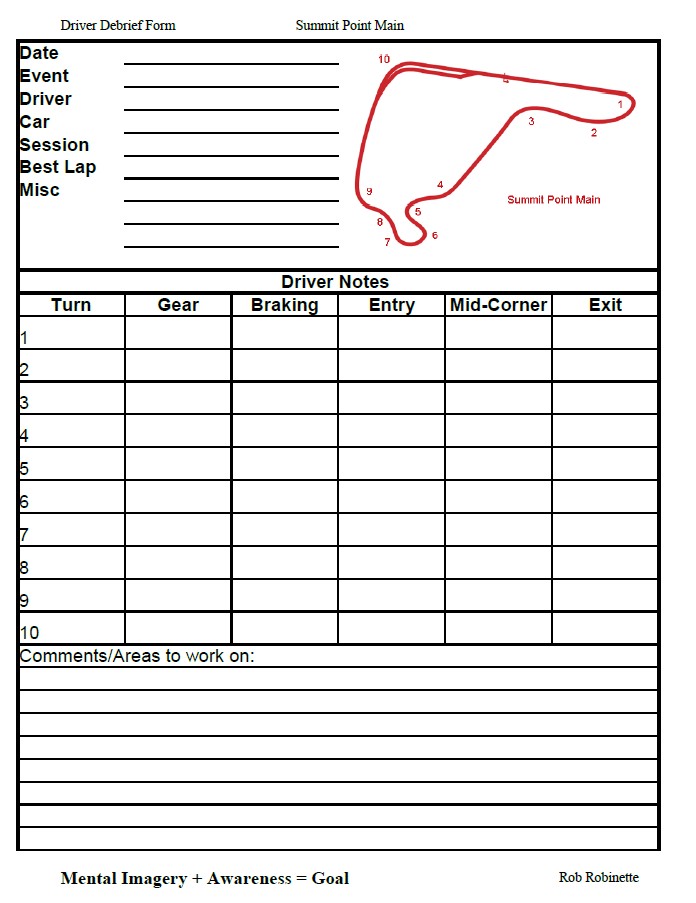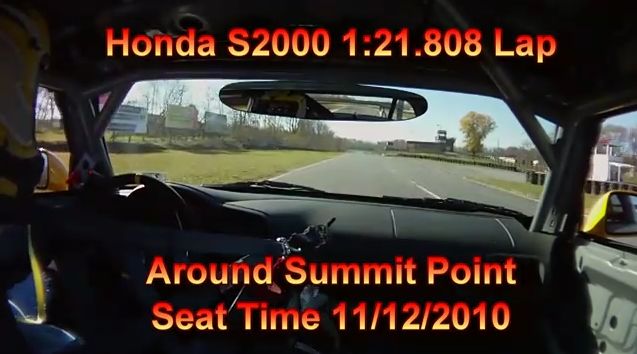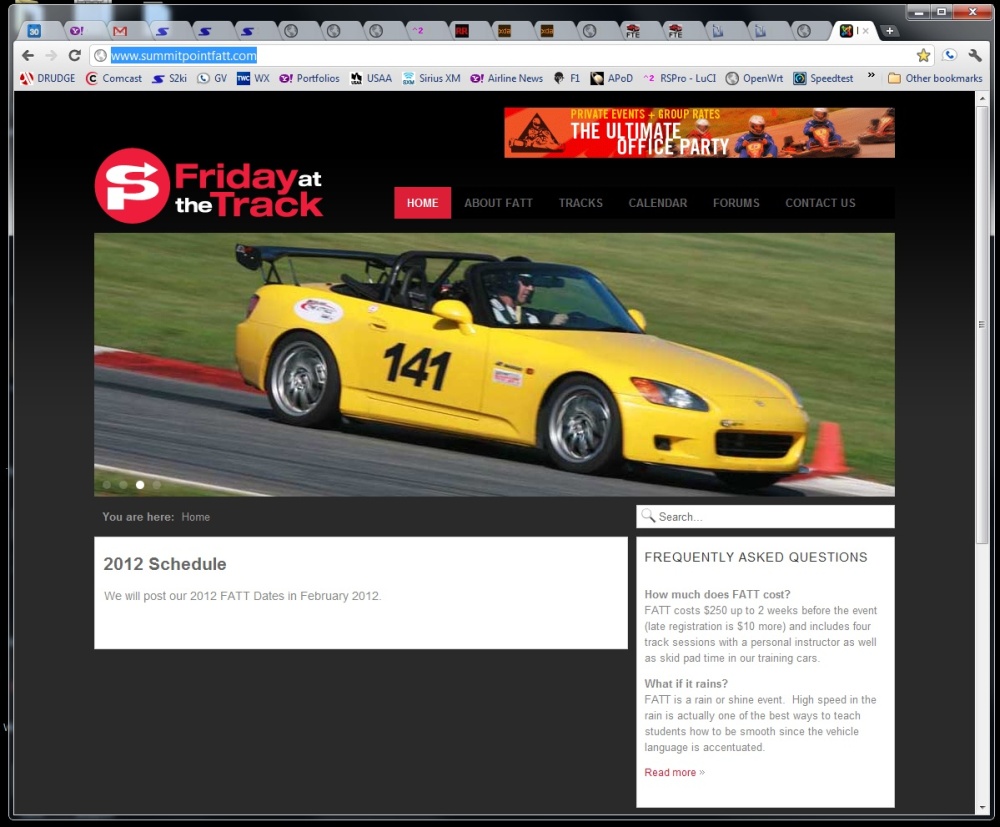A
Hot Lap Around Summit PointBy Rob Robinette
I live 30 minutes from Summit Point and have been instructing and competing there for many years. The following is my narrative of how to get the best out of a race prepped Performance Touring (PTB) S2000 on Summit Point's Main circuit. In November of 2010 I turned a 1:21.7 lap using the following techniques.
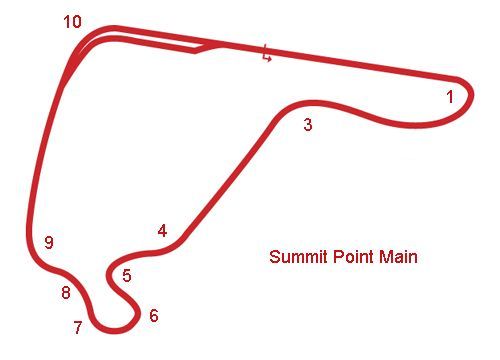
Standard Turn Numbers
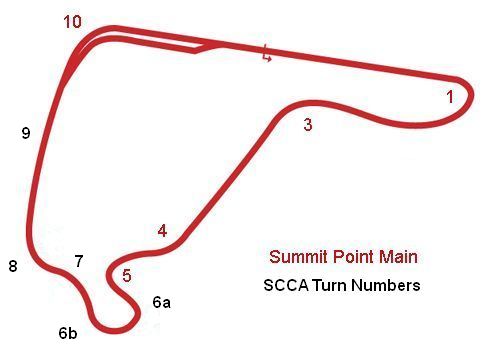
SCCA Turn Numbers
Turn 10

Summit Point Main Turn 10
A fast lap around Summit Point Main begins and ends in Turn 10. Because it leads onto the start/finish straight you must get it right twice to turn a good lap. It is by far the most important corner on The Point not only because it leads onto the longest straight, but because it's a high speed corner that leads onto the longest straight. Ross Bentley, in his "Speed Secrets" series of books, describes how the speed differential between a good driver and a great driver will be greatest in high speed corners where skill and bravery separate the men from the boys. The speed differential between a good and great driver in a slow tight corner will be two or three miles per hour where the difference in a high speed corner can be over ten. So make Turn 10 your initial focus.
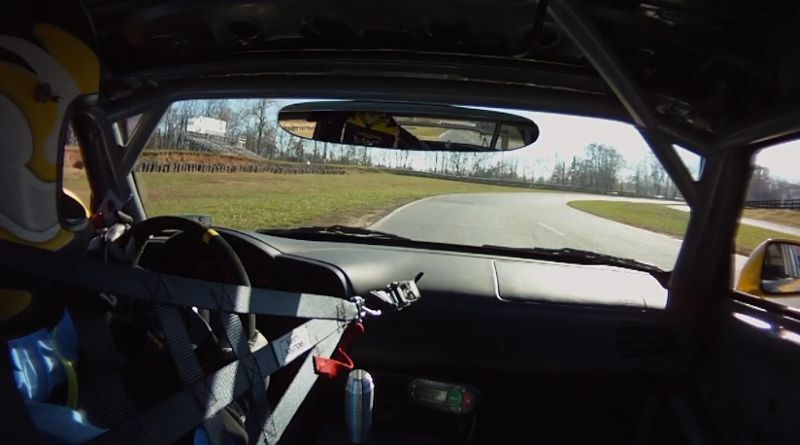
Summit Point Turn 10 Entry @ 95mph (TraqMate data acquisition speed)
Don't try to late brake Turn 10. Most drivers will be quicker if they brake a little earlier and easier than they normally would. This allows you to get the down shift completed and focus on your entry speed. Braking early will also ensure the car is settled when you turn in. Entry speed is paramount for Turn 10. It's very common to realize after turn in you could have carried more speed.
After passing under the center of the bridge on the approach to Turn 10 you'll be approaching the corner from the center of the track so make sure you make it all the way out to the outside edge of the track. A common error is to cheat toward the apex before the correct entry because the tack begins to turn before you should. Turn in needs to be smooth to keep the car settled and as soon as it is, it's time to smoothly add throttle--usually well before the apex.
Many of the turns at Summit Point have repair patches that arc along the proper racing line near the apex. Use these "arcs" to analyze your turn in and line through the corner. If you are inside the arc moving outward you turned in early and are heading off track. If you find the arc patch to your inside you turned in late. If your outside wheels are tracking along the arc you are on line and can use that to boost your confidence and add throttle earlier.
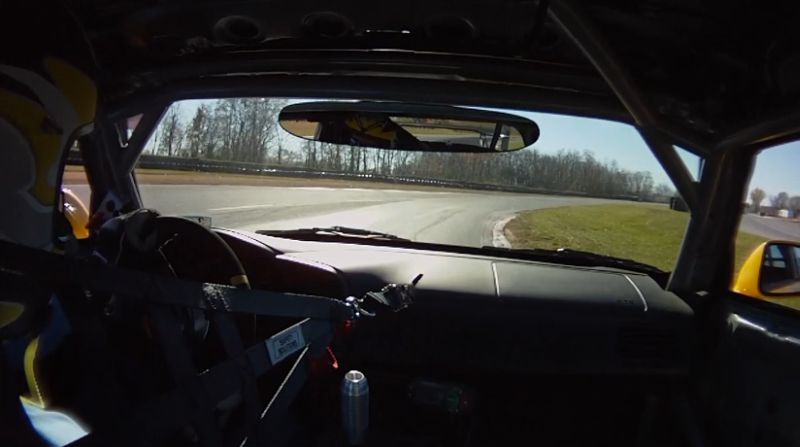
Turn 10 Apex @ 91mph
At the apex your inside wheels should touch or ride over the curbing. The Honda S2000 may spin its inside rear wheel at full throttle if too much curb is taken. A car with a more robust differential can actually use the dirt on the inside of the curb. At turn exit I like to put at least two wheels on the red and white painted "dragon teeth"--the bumpy apron. If you get the corner just right you'll have all four wheels on the apron, it's wider than you think and traction is good in the dry. Use a slow lap behind traffic to put all four wheels on the apron to see just how wide it is. You need to use this part of the track to maximize your speed through Turn 10. You might not want to do this every lap though because the bumps are pretty sharp and they may wear on your expensive track tires.
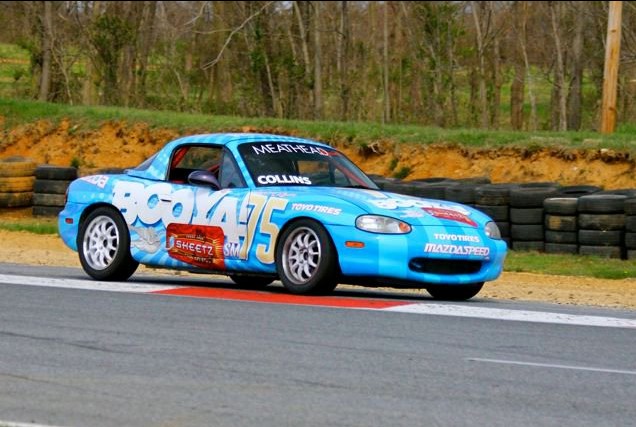
Mike Collins Completely Outside the Curbing at Turn 10 Exit
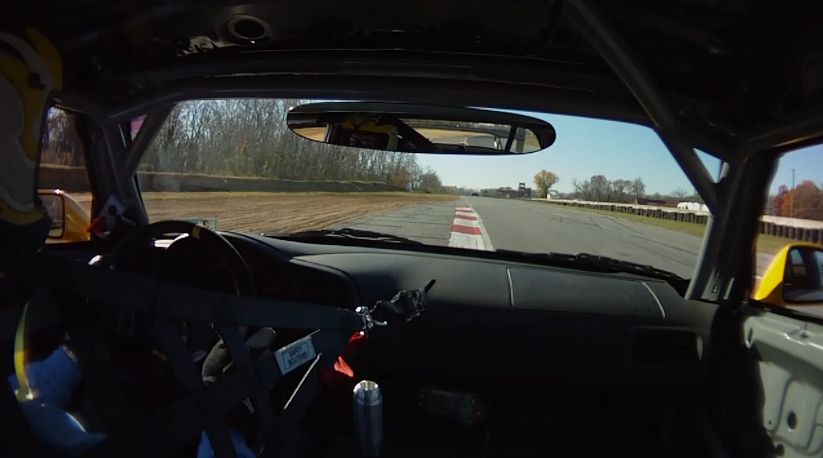
Turn 10 Exit Outside the Curbing @ 99mph
If you do happen to go off in Turn 10 the gravel trap will normally stop you without damage. If you go off at corner exit the transition from gravel to dirt along side the track is normally well groomed and can be managed to smoothly move back onto the track without incident. You may have to delay your return to the asphalt until the difference in height between the dirt and track lessens. Keep it gradual in any case. Some drivers do this on a regular basis without lifting.
Use the Front Straight to take a few deep breaths, wiggle your fingers for a lighter grip on the wheel, check the rearview mirror and the engine instruments for health.
Turn 1
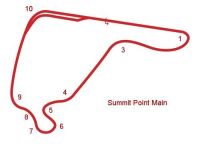
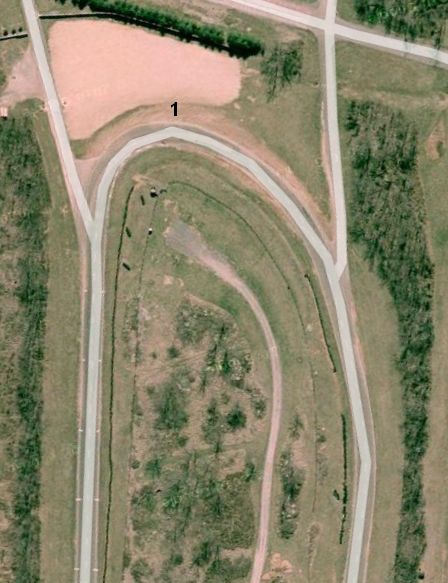
Turn 1
Turn 1 is approached from the highest speed attained on the track. My S2000 hits 130 mph (true speed from data acquisition) at the braking zone for Turn 1. This high speed approach makes it difficult for some to delay braking until it's really needed. It is common to find yourself easing up on the brakes because you got on them too early.
Turn 1 is a relatively slow, downhill increasing radius turn that leads to an uphill acceleration to Turn 3. The uphill climb makes exit speed in Turn 1 important. My S2000 needs trail braking to get the front grip to rotate into the corner. When I get this turn just right it always feels like I'm carrying too much speed at turn in but the heavy trail braking makes it work out.
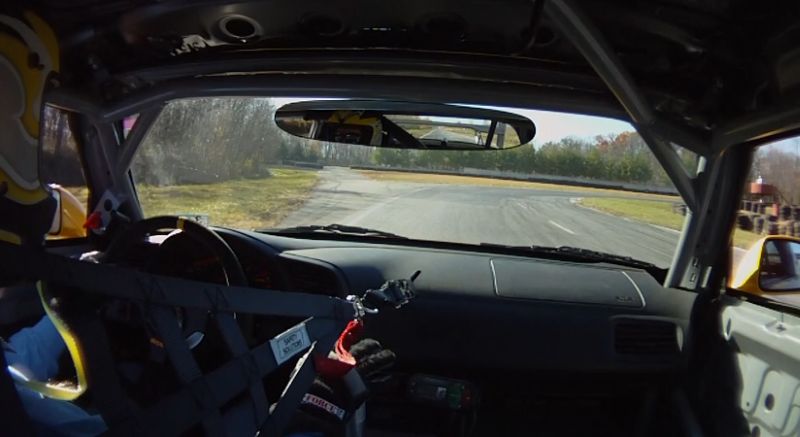
Turn 1 Entry @ 64mph - A Smooth Turn In Is Critical
Many complain of understeer followed by oversteer in Turn 1. A common mistake is to turn in abruptly which leads to understeer, then the front end regains its grip about the time you're adding throttle so the car moves directly into oversteer just before the apex. You can prevent this with a precise turn in reference and smooth turn in and throttle application.
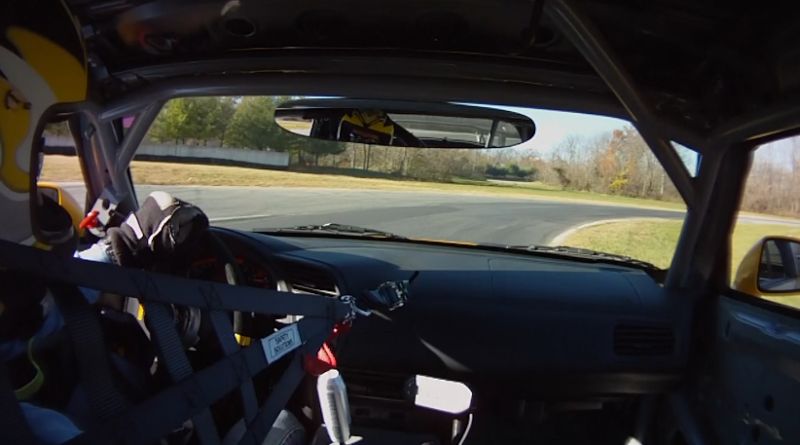
Turn 1 Apex @ 49mph
You want to just touch the curbing at the apex but too much curbing can lead to inside wheel spin and loss of acceleration. High horsepower cars will benefit from a slightly late apex which will allow earlier throttle application. Track out should not be reached until the far edge of the skid pad access road coming in from the left. A common mistake is to turn in too early which requires throttle feathering as you approach track out. You must turn in to allow full throttle acceleration from the apex out to minimize the impact of the long uphill acceleration.
Turn 1 is slippery in the wet and most drivers will avoid the dry line by running a little deeper into the corner and missing the apex by about 10 feet or so.
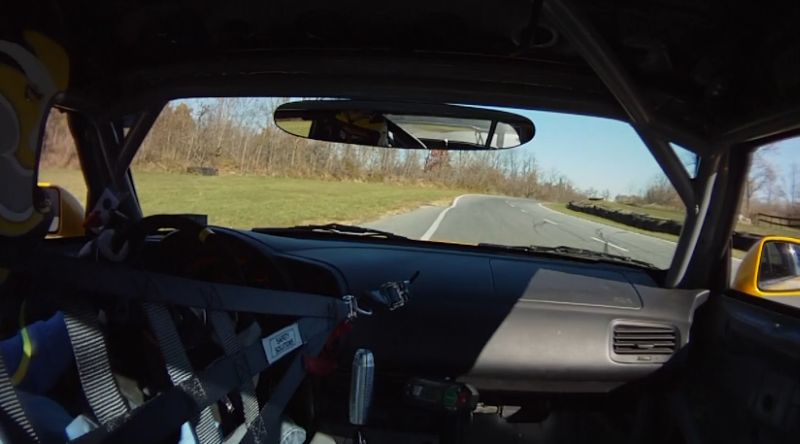
Turn 1 Exit @ 88mph - Use the Access Road
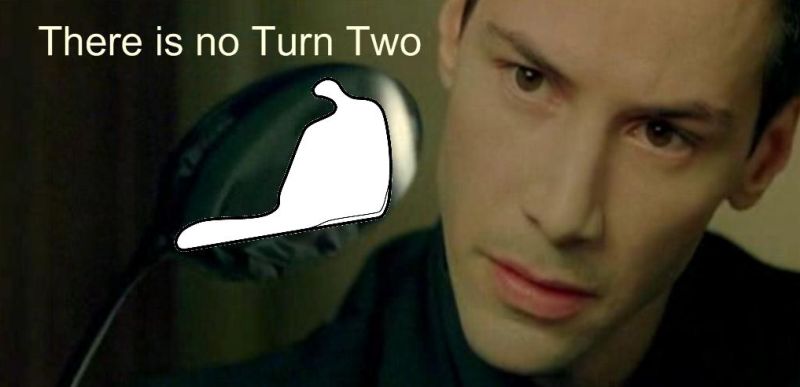
Graphic by George
Turn 3

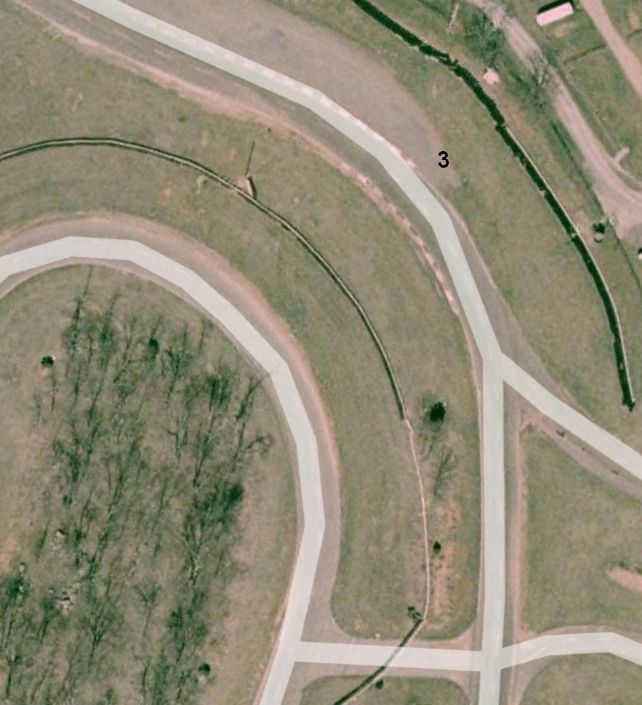
Turn 3
As you exit Turn 1 smoothly move diagonally across the track to the Turn 3 entry. A straight line from Turn 1 exit to Turn 3 entry will shorten the track. Turn 3 is a tricky, blind, uphill corner that will make you smile in your helmet when you get it right. I personally believe this is the second most important corner on The Point. A geometric apex (neither early or late) is usually the fastest way through Turn 3. The most common errors in Turn 3 are over braking and late turn in. The braking zone is steeply uphill and you'll lose more speed than you're expecting. Again, brake a little earlier and lighter than you normally would so you can focus on entry speed and a smooth turn in. Do this and the car will be more settled for maximum cornering grip.
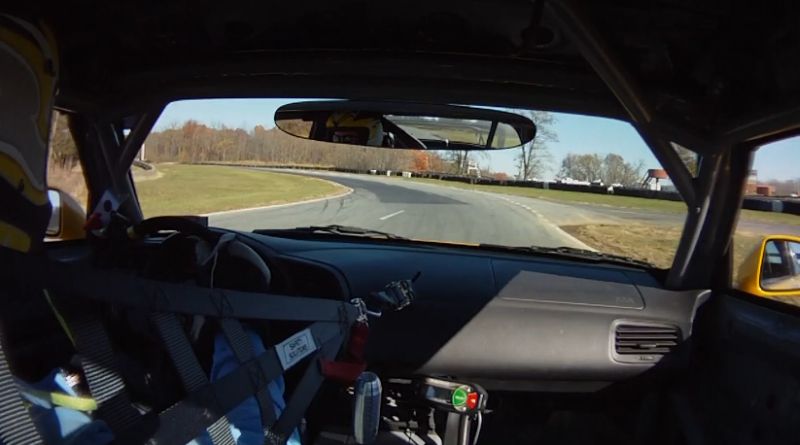
Turn 3 Entry @ 100mph - Smooth, Early Turn In
A technique for learning a high speed technical turn like this is to brake very early and lightly and purely focus on a fast entry speed and smooth turn in. This will keep your subconscious from overriding your right foot and braking more than you really want. Once you're comfortable and you can consistently get through the corner carrying good speed slowly work on later braking.
Like Turn 10 the track will begin to turn before you should so make sure you're at the outside edge at turn in. I begin my turn in about halfway between the two access roads on the right. You can see the second access road in the picture above. Look for the repair patch arc on the racing line to judge your line and smoothly feed in full throttle. Due to the steep uphill entry you can get on the throttle earlier than you would think. Be careful taking apex curb here, too much will upset the car just as you're cresting the hill and the car is at its lightest--be ready to correct for a little oversteer cresting the hill in any case. The fast line will have you crossing the arc patch from inside out toward the exit curbing.
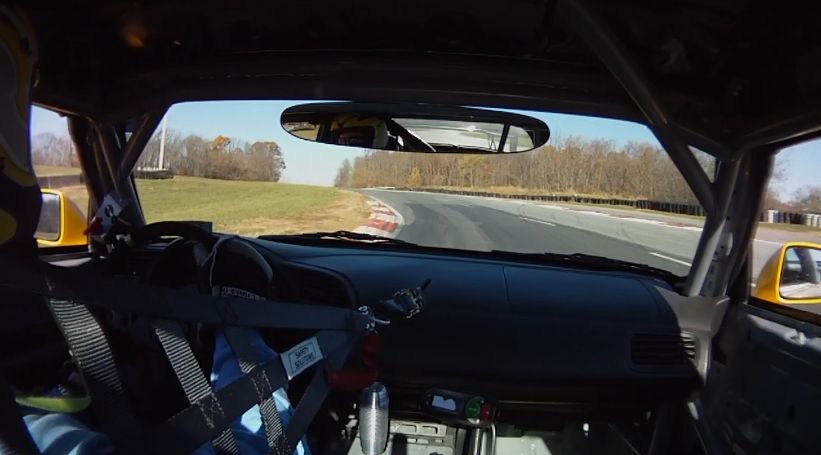
Turn 3 Apex @ 88mph - Steeply Uphill - Watch the Crest
At turn exit you should have your outside wheels skirting or even in the gravel trap. If you do run through the trap don't freak out, the track will turn back to you and the transition from gravel to dirt is smooth so you can normally drive out at high speed without incident. BSR driving instructors intentionally drive through this trap at high speed during training to prove that it's not the end of the world. BSR recently enlarged the gravel trap outside Turn 3 and it's a much safer corner now. The picture above shows the old, smaller gravel trap.
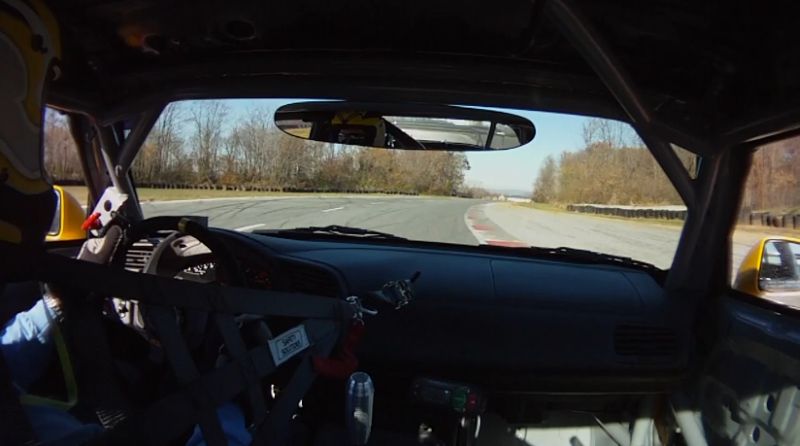
Turn 3 Exit @ 91mph - In Or Near the Gravel
Turn 4 "The Chute"

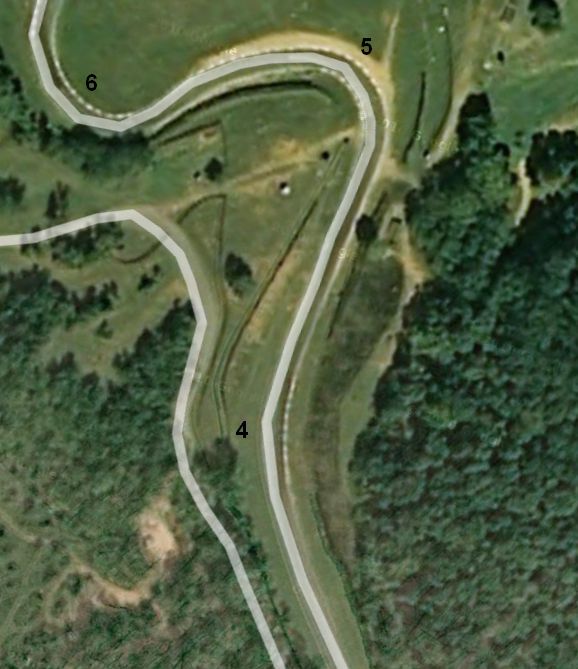
Turns 4 & 5
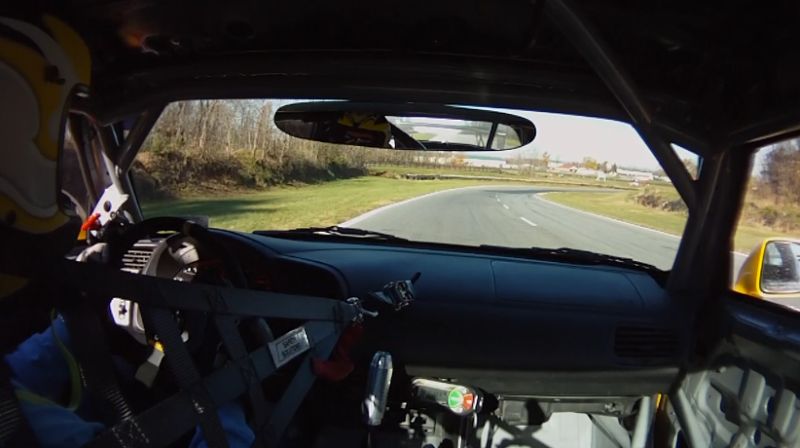
Turn 4 Entry @ 104mph - No Trail Braking Here
Turn 4 is the fastest turn on the circuit. It's downhill into a narrow valley lined with tires. Spin here and it's difficult not to do some serious damage so temper your aggression in The Chute. I do not recommend trail braking into Turn 4. There's a bump just after turn in which will loosen the rear end and trail braking can quickly lead to severe oversteer. A light tap of the brakes or just a smooth feather of the throttle before turn in will keep the car stable at turn entry.
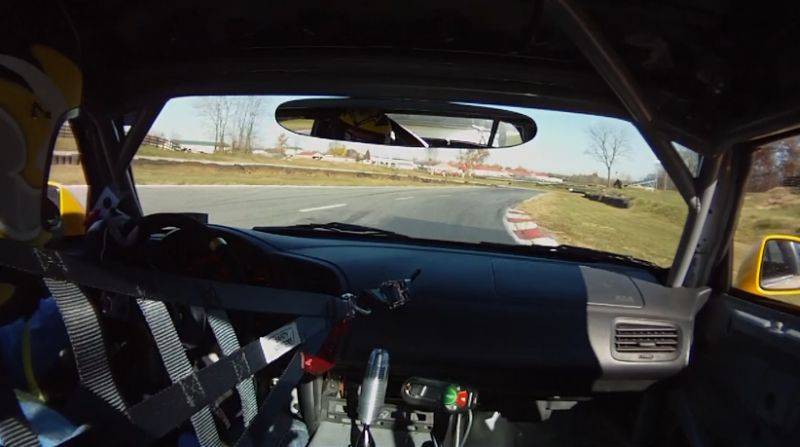
Turn 4 Apex @ 103mph - Summit's Highest Speed Corner
I turn in where the outside of the track begins its bend to the right. Be very careful with the inside curb. If you get the turn right you'll be on the absolute edge of traction at 100+ mph and a bump from the apex curb can cause everything to go to shit very quickly. After feathering the throttle before turn in I smoothly go back to full throttle and hold it until I track out at the left edge of the track. Just as the car is straightened it's time for hard downhill braking for Turn 5. Do not slow and move to the right side of the track for the Turn 5 entry, you'll be much quicker if you keep your speed through Turn 4 and enter Turn 5 from between the left side and middle of the track. Keeping left will also prevent a competitor from stealing the inside line into Turn 5.
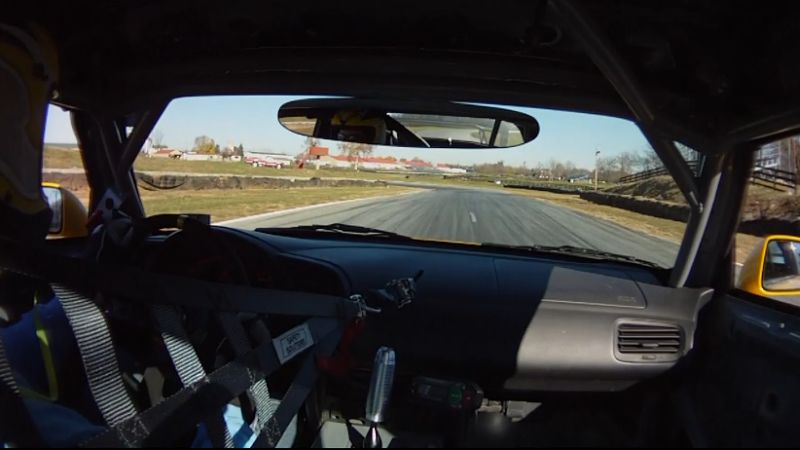
Turn 4 Exit and Hard Downhill Braking @ 105mph
Turn 5

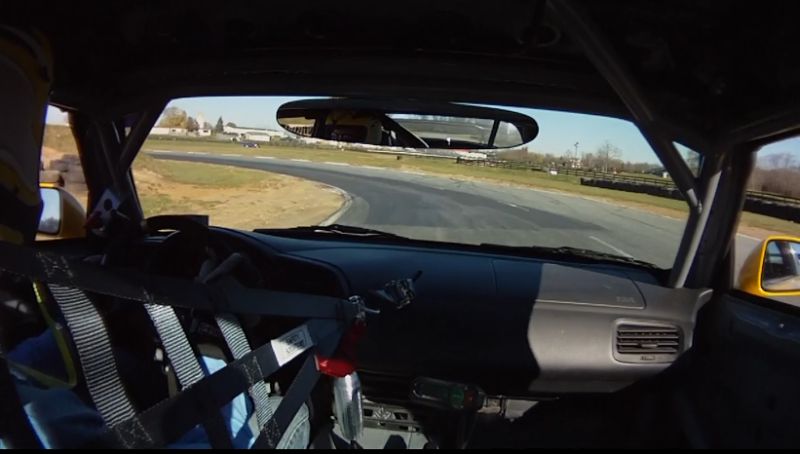
Turn 5 Entry @ 72mph - Lots of Positive Camber So Trail Brake & Carry Speed
Turn 5 has a nice positive camber that will allow you to trail brake heavily and carry more speed than you would think. If you over cook the corner and begin to spin lock up the brakes early and you'll slide harmlessly into the infield. Lock the brakes late and you can hit the inside wall--don't ask me how I know. When you get the corner right you'll go directly from braking oversteer to throttle oversteer as you accelerate into Turn 6.

Turn 5 Apex @ 49mph
Notice I slowed from 72mph at turn in to 49mph at the apex by using heavy trail braking. Even though I entered Turn 5 from the "wrong" side of the track I normally don't go all the way out to the outside edge of the track at corner exit. I usually end up about 3/4 of the way out toward the exit. Turn 5 is something of a low speed "throw away" corner but you can and should carry good speed through it. It's very common to over slow at turn entry. Another common error is not using a short full-throttle blast from Turn 5 exit across the track to Turn 6 entry.
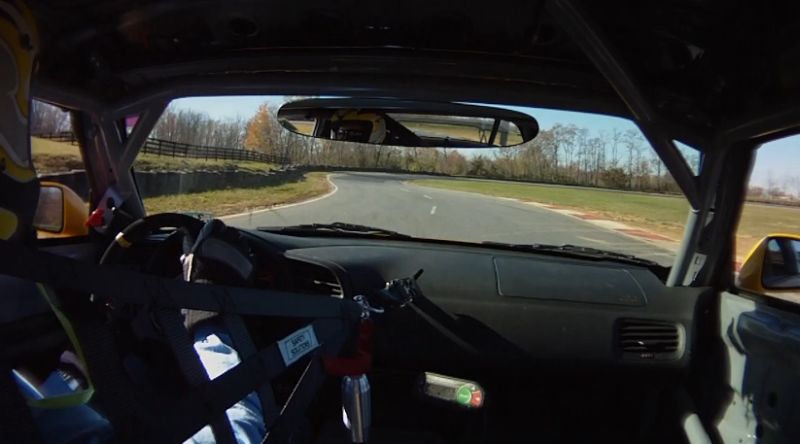
Turn 5 Exit @ 57mph & a Full Throttle Blast to Turn 6
Turns 6, 7, 8 and 9 "The Caroussel" & "Esses"
(SCCA Turns 6a, 6b, 7 and 8)

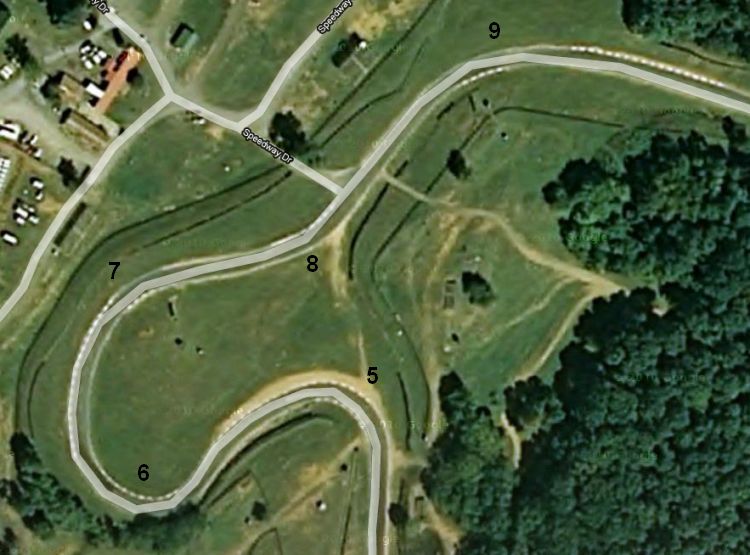
Turn 6, 7, 8 and 9 (SCCA Turns 6a, 6b, 7 and 8)
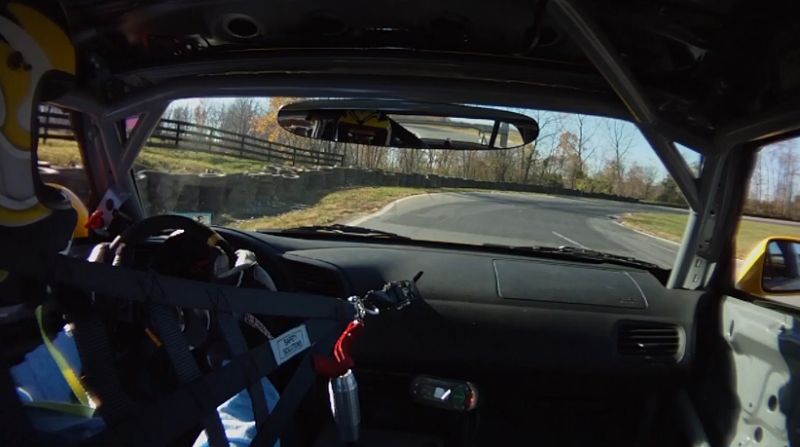
Turn 6 Entry @ 58mph - Trail Brake Here
Turns 6, 7 and 8 are all about maximizing Turn 9's entry position and speed. Turn 9 is another high speed corner leading to an uphill straight. Depending on who you ask it's either the second or third most important turn on the track. When you get this set of turns right you will be accelerating hard from Turn 6's apex all the way through Turn 9.
Turns 6 and 7 are really just one big double-apex turn--the exit of Turn 6 is the entry point for Turn 7. This is why the SCCA refers to Turn 7 as Turn 6b. After accelerating hard out of Turn 5 to cross the track, trail braking into Turn 6 will help rotate the car--but don't over slow. All that's needed is a quick dab of the brakes to weight the front of the car for turn in.
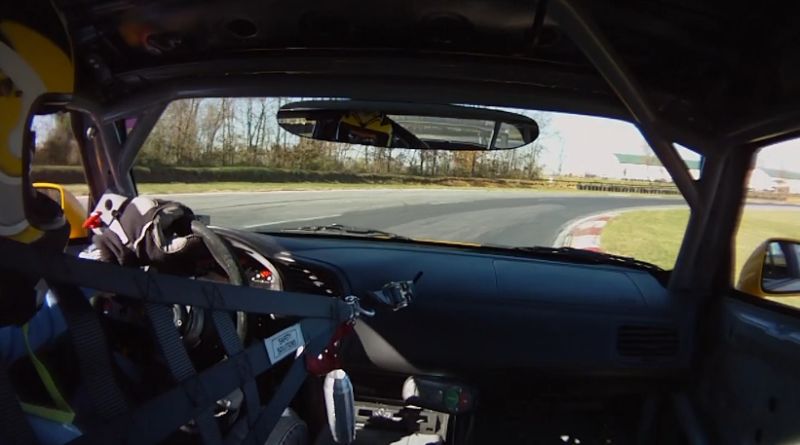
Turn 6 Apex @ 51mph
I have to miss the apex curbing by a foot or two to avoid some bumps that cause inside wheel spin (thanks for the suggestion Pete). Use the arc repair patches to guide you through these turns.

Turn 6 Exit and Turn 7 Entry @ 61mph
From the apex of Turn 6 I accelerate at full throttle which pushes the car out toward the edge of the track. Coming off the throttle for the shift to third allows the car to stay on track close to the outside curbing, but don't use the outside curbing here, it has too much negative camber and not enough grip. Once in third gear I smoothly and immediately go back to full throttle. When I get the corner right I can stay at full throttle and still get the car to turn in to clip the curb at the Turn 7 apex. Other times I have to feather the throttle to transfer some weight to the front tires to get the car to rotate toward the apex.
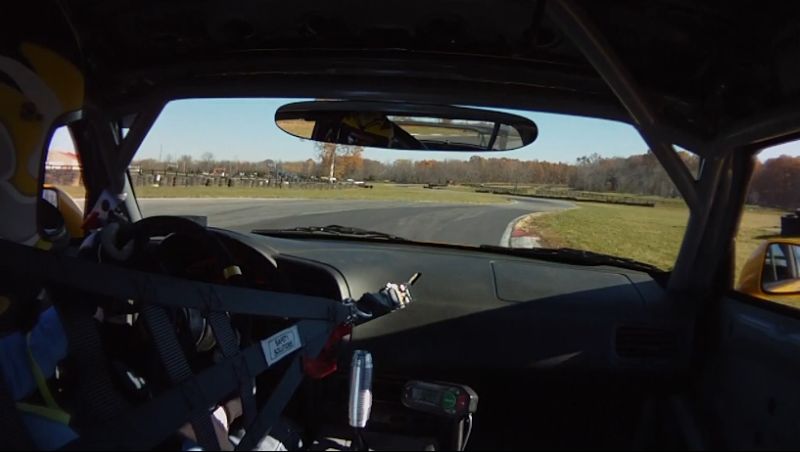
Turn 7 Apex @ 68mph
After clipping the curb at the Turn 7 apex it's time to begin slowly and smoothly unwinding the steering wheel and going from a tail left slide to a tail right slide to clip the curbing at Turn 8. This should be done in one smooth movement of the wheel, there's no need to pause and straighten the the car. You want a nice late apex at Turn 8 so you're set up for a shallow turn in to Turn 9.
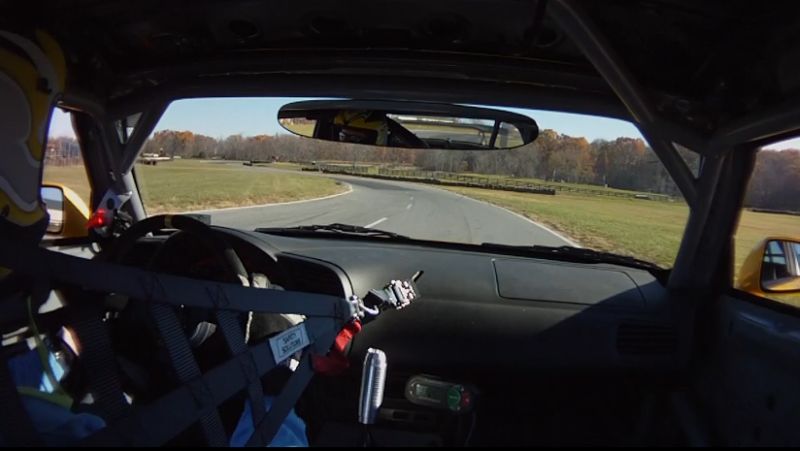
Turn 7 Exit and Turn 8 Entry @ 74mph - Keep the Transition Smooth
You will need another smooth transition as you go from the Turn 8 exit to the Turn 9 entry point at the left edge of the track. There's no need to pause and track straight toward the Turn 9 entry. Your steering input should take you from a slight tail right slide to a tail left slide as you begin your turn in for Turn 9.
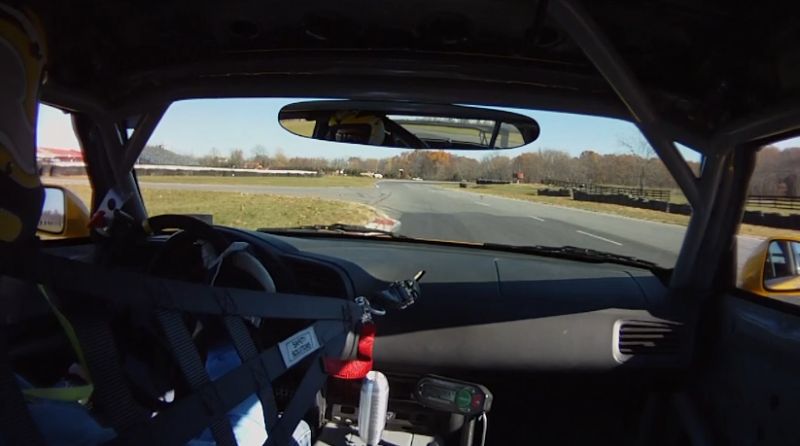
Turn 8 Late Apex @ 81mph
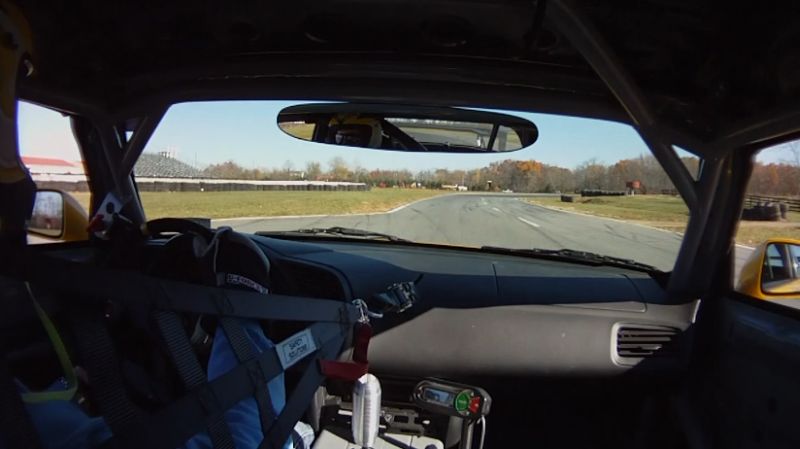
Turn 8 Exit @ 84mph
A geometric apex (neither early or late) is the fast way through Turn 9. After the apex you will be crossing the arc patch toward track out. The inside curbing is smooth and should be used but be aware of the "hole" after the apex where the inside curbing ends.
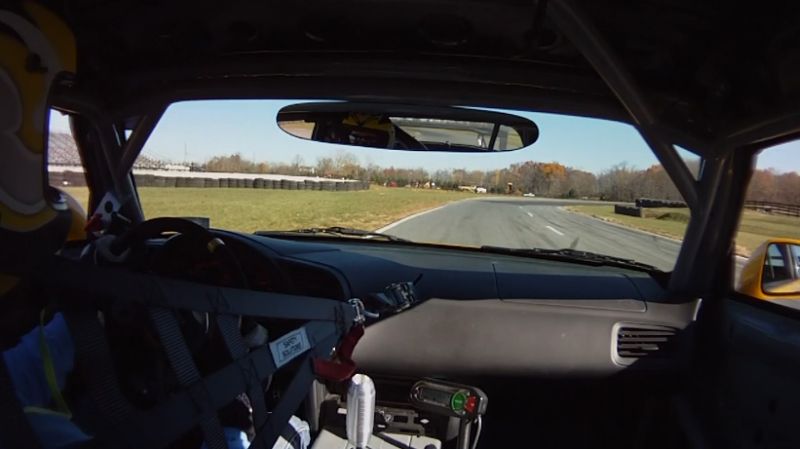
Turn 9 @ 86mph - Smooth Early Turn In
Turn 9 is another important fast corner leading onto the uphill Bridge Straight. There's not a lot of runoff here so temper your aggression. Most spins in Turn 9 occur when the rear end steps out after hitting the bump just past the apex or after topping the crown in the middle of the track--be ready to add some counter-steer after the apex--especially in the wet. Turns 4 and 9 are responsible for more damaged cars than any other part of the track.
In the picture above it looks like I'm turning in very early--note the yellow tape on the steering wheel. At full throttle I have to fight understeer at the Turn 9 entry so I have to turn early, slowly and smoothly to keep the front tires from sliding too much.
Through Turn 9 is where I see the biggest difference between standard R compound tires such as the Nitto NT01 and stickier Hoosier R6s. The NT01s will only slide so much with understeer whereas the Hoosiers are much happier with high slip angles. When the front Hoosiers begin to slide I can add a lot more steering and the car will respond, where the NT01s will just keep sliding requiring a lift of the throttle to rotate the car toward Turn 9's apex.
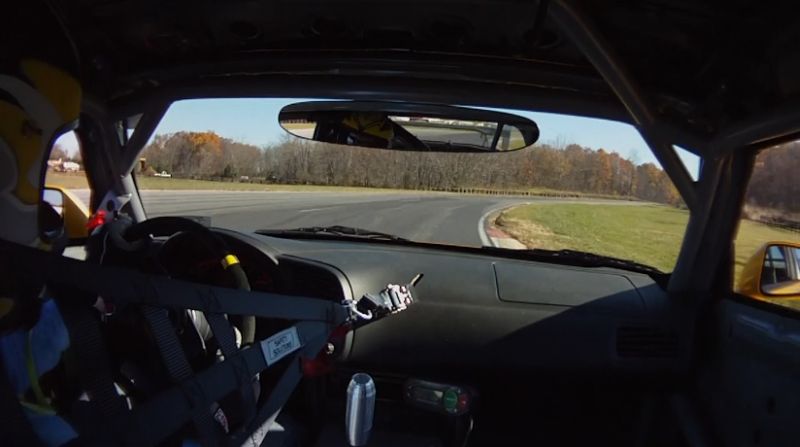
Turn 9 Apex @ 89mph (note the hole where the curbing ends)
Use the apex curbing but beware of the hole located where the curbing ends. There's a bump after the apex that may require an oversteer correction and the track drops off into negative camber after the crown of the track. These two bumps make Turn 9 the most commonly spun corner on the track. Be careful adding throttle in the wet, Turn 9 is very slick when wet. The combination of adding throttle, the bump of the road crown, then negative camber has caught many drivers by surprise.
You can use the exit curbing but be careful, it has even more negative camber than the track and it abruptly ends just beyond the normal track out.
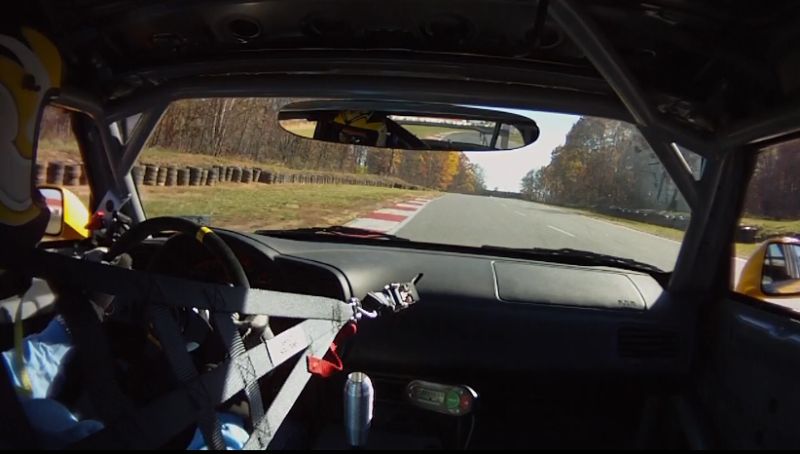
Turn 9 Exit @ 98mph
At track out aim for the center of the bridge which will line you up for the entry into Turn 10. If you can, delay your up shift until after the crest of the hill. Don't forget, don't late brake Turn 10--focus on entry speed and a smooth turn in.
Here's a driver debrief form for Summit Point. It was created following the guidance in the book, "Speed Secrets." Download the pdf version here.
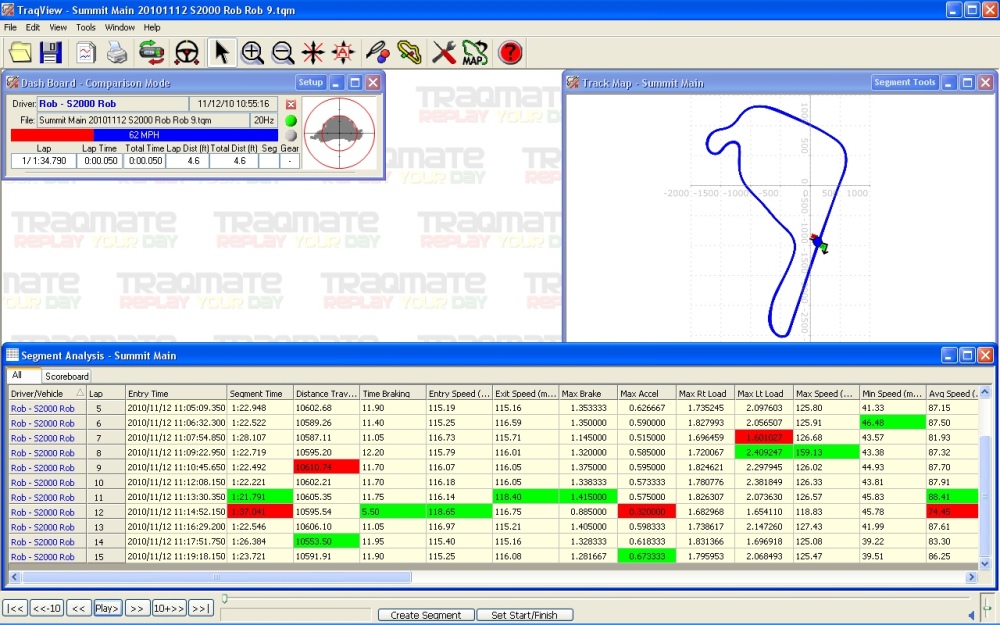
Data From 1:21.7 Lap
That's Summit Point in a nutshell. Now get out there and trim your lap times!
To see these techniques in action see this HD YouTube video of my Honda S2000 turning a 1:21.8 lap around The Point:
http://www.youtube.com/watch?v=fjz-kapmMZ8
YouTube Video
More information about Summit Point Raceway can be found here: http://www.summitpoint-raceway.com/
Info on the BSR Friday At The Track (FATT) track days can be found here: http://www.summitpointfatt.com/
